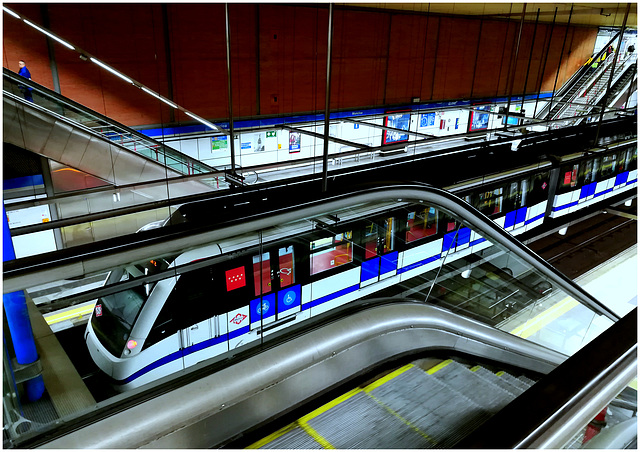Railway sculpture
HFF, everyone!
Principe Pío metro and main line station, Madrid
Tres Cantos railway station. Storm approaching fro…
Principe Pío metro and mainline station, Madrid.
Principe Pio, Mainline and metro station, Madrid
Lines. Metro station Moncloa, Madrid
Through train.
Long tunnel
HFF everyone!
HFF everyone.
Moncloa metro station, Madrid
Mar de Cristal Metro Station, Madrid
Sleeper art
HFF, everyone!
Teleferico, Casa De Campo, Madrid.
HFF Everyone!
Metro mural.
Principe Pío metro and main line station. Madrid
This is only a short stretch of a very long walkwa…
A MacDonald Douglas (apparently) at Colombia Metro…
Príncipe Pío metro and main line station, Madrid.
When two trains fall in love.
Principe Pio
HFF everyone!
In danger of being knocked over by cyclists!
HFF, everyone!
Principe Pio metro and mainline station, Madrid
Principe Pio
Moncloa metro station
HFF everyone!!
HFF everyone!
Villaverde Bajo station, Madrid
Villaverde Bajo railway station, Madrid
HFF Everyone! The through train. And I have to…
Príncipio Pío (formerly Estacion del Norte)..
Metro de Madrid
Train leaving the station
Príncipe Pío, old and new.
Mar de Cristal metro station, Madrid
Madrid from the teleferico.
Casa de Campo and North-western Madrid from the te…
Madrid from the Teleferico
Sol Metro and main line station, Madrid
Day of the Dead Tunnel Walk
Location
Lat, Lng:
You can copy the above to your favourite mapping app.
Address: unknown
You can copy the above to your favourite mapping app.
Address: unknown
See also...
Keywords
Authorizations, license
-
Visible by: Everyone -
Attribution + non Commercial + no derivative
-
236 visits
Moncloa metro station.


Madrid public transport.
Translate into English
micritter, A. R., Fred Fouarge, ROL/Photo and 24 other people have particularly liked this photo
- Keyboard shortcuts:
Jump to top
RSS feed- Latest comments - Subscribe to the comment feeds of this photo
- ipernity © 2007-2025
- Help & Contact
|
Club news
|
About ipernity
|
History |
ipernity Club & Prices |
Guide of good conduct
Donate | Group guidelines | Privacy policy | Terms of use | Statutes | In memoria -
Facebook
Twitter

All very modern looking but the train and station are already over 20 years old!
Madrid metro celebrates its centenary in 2019
Andy Rodker club has replied to Jenny McIntyre clubAndy Rodker club has replied to tiabunna clubAdmired in:
www.ipernity.com/group/tolerance
Re: Bouillon:
In the Middle Ages Bouillon was a lordship within the Duchy of Lower Lorraine and the principal seat of the Ardennes-Bouillon dynasty in the 10th and 11th century. In the 11th century they dominated the area, and held the ducal title along with many other titles in the region. Bouillon was the location of the ducal mint and the dominant urban concentration in the dukes' possession.[2]
The Semois river and the Bouillon Castle (13th/19th centuries)
There is a common misconception that Bouillon was a County. While the lords of Bouillon often were counts and dukes, Bouillon itself was not a county. The fortification of Bouillon Castle was, along with the County of Verdun, the core of the possessions of the Ardennes-Bouillon dynasty, and their combined territory was a complex mixture of fiefs, allodial land and other hereditary rights throughout the area. An example of the latter is the Advocacy of the monastery of Saint-Hubert en Ardennes, which was granted to Godfrey II by the prince-bishop of Liège.[3]
The most famous of the Lords of Bouillon was Godfrey of Bouillon, a leader of the First Crusade and the first ruler of the Kingdom of Jerusalem. He sold Bouillon Castle to the Prince-Bishopric of Liège. The prince-bishops started to call themselves dukes of Bouillon, and the town emerged as the capital of a sovereign duchy by 1678, when it was captured from the prince-bishopric by the French army and given to the La Tour d'Auvergne family. The duchy was prized for its strategic location as "the key to the Ardennes" (as Vauban called it) and hence to France itself. It remained a quasi-independent protectorate, like Orange and Monaco, until 1795, when the Republican Army annexed it to France.
After the defeat of Napoleon Bonaparte, the city was given to the Netherlands in the 1815 Treaty of Paris. It has been part of Belgium since the Revolution of 1830.
Andy Rodker club has replied to Soeradjoen (limited…Andy Rodker club has replied to Marie-claire Gallet:o)
3 days later - and I am very confused. Who is commenting on whose Photo??? :o)
And as Larry also said, I wish I had taken it.
John,
Pleased with both your compliments about the conception and that you would both have been chuffed to have take it!
I am humbled!
Christmas Greetings, Herb
Andy Rodker club has replied to ROL/Photo clubSign-in to write a comment.